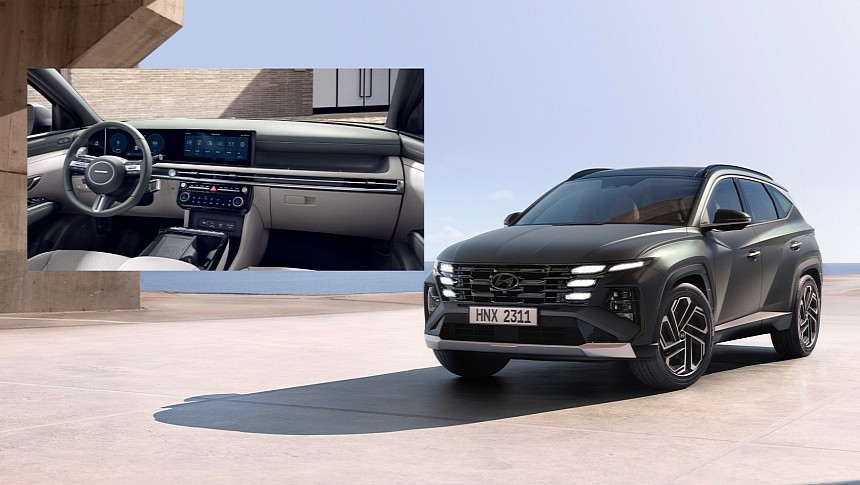The South Korean automaker decided its eccentric exterior didn't need many changes; the considerable modifications come from inside where the cabin looks way cooler – it has that 'looks like a spaceship' vibe that's so 2023.
Hyundai introduced the popular Tucson compact crossover SUV after carefully observing the rapidly rising level of popularity of the slightly larger Santa Fe. The latter was a significant threshold for the company's reshaping image as it faired extremely well among American customers. Naturally, they probably thought the name had something to do with it – Santa Fe was named after the city in New Mexico.
As such, it is no wonder their next CUV – launched in 2004 after Santa Fe was introduced in 2000 – was labeled after the city of Tucson, Arizona. Again, they struck gold and limited costs because the model was developed alongside the Kia Sportage, sharing both the architecture and powertrains. In time, it has become Hyundai's top-delivered SUV, and a big chunk of the sales come from places like Europe, America, or Australia.
Well, we don't know yet about the North American version. Still, the Old Continent and the Land Down Under are getting a refreshed Tucson starting early next year – and Hyundai is officially showcasing it with the first pictures and details. It arrives packing "a more dynamic appearance that embodies the company's progressive vision for future mobility." Full details are currently unavailable – European and Australian specifications are coming "in the near future."
However, we already know the Tucson facelift will arrive on the Old Continent first, followed by the Australian version in mid-2024, along with a new Hybrid powertrain variant for Australia. Let us be honest from the start – unless you glimpse the cockpit, it will be hard to make out the facelift from the current Tucson. So, the 'Parametric Dynamics' styling remains intact, with a slightly redesigned front fascia, fresh alloy wheel designs, and a rear skid plate integrated into the bumper and styled wider.
Inside, Hyundai is more than a little poetic about the new cockpit: "The interior of the new Tucson prioritizes spaciousness and practicality, achieved through a horizontal design that creates a sense of openness. The seamless integration of advanced technology elements ensures a harmonious blend of functionality and aesthetics." Now, let us translate that for you. First and foremost, the four-arm steering wheel is replaced with a sportier design – and the steering column also hosts the transmission switcher for the automatic gearbox.
The second major change is the integration of the digital instrument cluster and infotainment system's touchscreen display into a singular slab of glass towering above the dashboard. Meanwhile, the controls for the climate system remain placed in their usual position, now separated from the system interface by the HVAC vents. Overall, this design is very much like the norm for 2023 and beyond – clearly a step forward in the right direction.
As such, it is no wonder their next CUV – launched in 2004 after Santa Fe was introduced in 2000 – was labeled after the city of Tucson, Arizona. Again, they struck gold and limited costs because the model was developed alongside the Kia Sportage, sharing both the architecture and powertrains. In time, it has become Hyundai's top-delivered SUV, and a big chunk of the sales come from places like Europe, America, or Australia.
Well, we don't know yet about the North American version. Still, the Old Continent and the Land Down Under are getting a refreshed Tucson starting early next year – and Hyundai is officially showcasing it with the first pictures and details. It arrives packing "a more dynamic appearance that embodies the company's progressive vision for future mobility." Full details are currently unavailable – European and Australian specifications are coming "in the near future."
However, we already know the Tucson facelift will arrive on the Old Continent first, followed by the Australian version in mid-2024, along with a new Hybrid powertrain variant for Australia. Let us be honest from the start – unless you glimpse the cockpit, it will be hard to make out the facelift from the current Tucson. So, the 'Parametric Dynamics' styling remains intact, with a slightly redesigned front fascia, fresh alloy wheel designs, and a rear skid plate integrated into the bumper and styled wider.
Inside, Hyundai is more than a little poetic about the new cockpit: "The interior of the new Tucson prioritizes spaciousness and practicality, achieved through a horizontal design that creates a sense of openness. The seamless integration of advanced technology elements ensures a harmonious blend of functionality and aesthetics." Now, let us translate that for you. First and foremost, the four-arm steering wheel is replaced with a sportier design – and the steering column also hosts the transmission switcher for the automatic gearbox.
The second major change is the integration of the digital instrument cluster and infotainment system's touchscreen display into a singular slab of glass towering above the dashboard. Meanwhile, the controls for the climate system remain placed in their usual position, now separated from the system interface by the HVAC vents. Overall, this design is very much like the norm for 2023 and beyond – clearly a step forward in the right direction.






